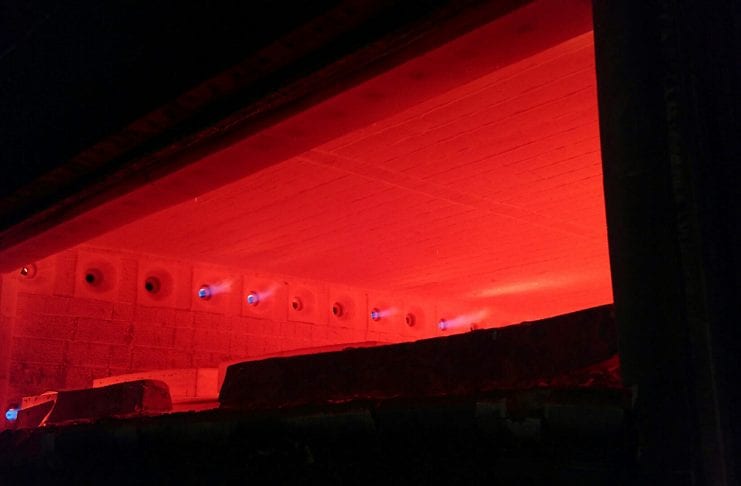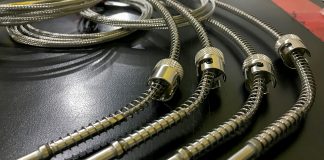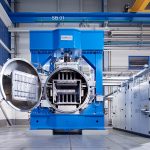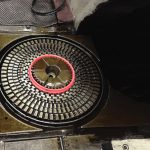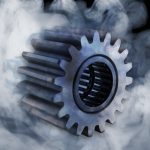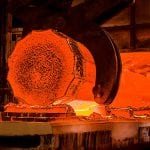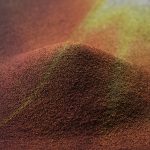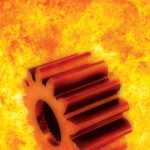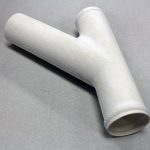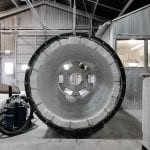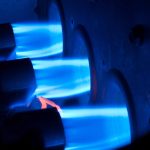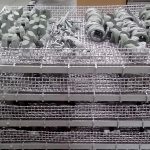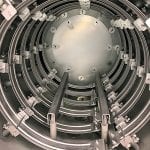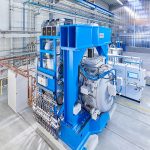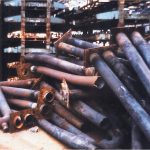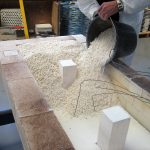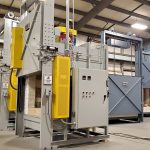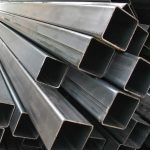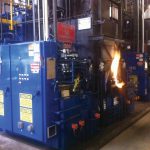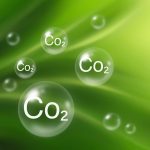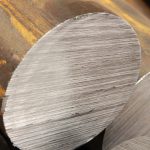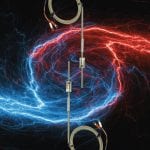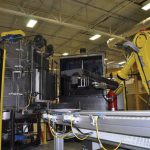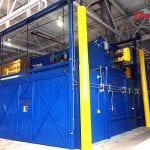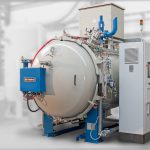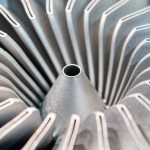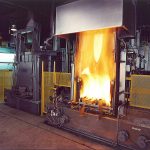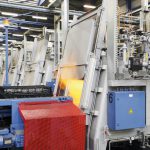Diffusion bonded printed circuit heat exchangers for severe environments
Traditional plate or shell and tube heat exchangers have long been used in processing industries. Today, however, with many new applications involving high pressures,...
Optimizing process operations
In integrated control system is the most effective way to enhance any complex industrial manufacturing process. A well-designed control system not only ensures greater...
Controlling Distortion in Heat Treatment Through Press Quenching
Introduction
Press quenching is a specialized quenching technique that may be utilized to minimize the distortion of complex geometrical components during heat treatment1. Distortion is...
Nitrogen gas quenching pressure effect on BS S155 alloy steel in vacuum furnace
The production of metal and alloy products requires the use of heat treatment. During the heat-treatment process, quenching is a crucial step. The quenching...
Operational efficiencies and minimizing energy consumption: An introduction
Energy conservation is the prevention of the wasteful use of energy. In today’s economic and climate-change environment, regulations and competition for resources require industrial...
Effects of the sintering process on Al2O3 composite ceramics
The sintering process can improve the microstructure of Al2O3 composite ceramics and enhance their comprehensive properties, but the effects of the sintering process on...
A Case for Acetylene Based Low Pressure Carburizing of Gears
Low pressure carburizing (LPC) is the technology of choice for the precise carburizing of high-performance gearing . To achieve absolute process repeatability and the...
Typical Heat Treatment Defects of Gears and Solutions Using FEA Modeling
Steel gears are heat treated to obtain enhanced properties and improved service performance. Quench hardening is one of the most important heat treatment processes...
Oxide-oxide ceramic matrix composites enabling widespread industry adoption
Oxide-oxide ceramic matrix composites are gaining increasing attention as a mainstream material option for high-temperature components in the aerospace and advanced energy sectors. As...
How to tame a plasma: Power-delivery solutions for top process issues
Film quality, throughput, yield, etch uniformity, and sidewall control all depend on the ability to ignite, maintain, and control a stable plasma. Precise, nimble...
New Simulation Software Tool Successfully Used in Carburizing Gears
In 1999 when the Center for Heat Treat Excellence (CHTE) was formed, the idea was to develop collaborative research between the industrial sector and...
Ceramic fiber module lining installation on a curved vessel wall
Ceramic fiber modules have been implemented in thermal oxidizer units (TOU) and vessels for more than 50 years, and they have become ubiquitous as...
Selecting the right stretch forming equipment
For manufacturers, striving to increase profitability while expanding their capabilities and improving their processes, adding stretch forming to their repertoire may be the answer.
Stretch...
Carburizing clean with Method 4
The existing model for removing soot from a furnace is a burn-out consisting of three methods:
Method 1: Remove the load, lower the furnace temp,...
Preventing eutectic reactions and diffusion bonding in vacuum processing
The purpose of this article is to explain reactions that can occur during a vacuum processing cycle and different methods of preventing these reactions....
Vacuum heat treatment for additive manufacturing
Additive manufacturing means any technology capable of obtaining a final component starting from a 3D CAD file and adding material layer by layer. At...
Carbo-nitriding of forging dies
Forging dies have to resist high mechanical and thermal loads. Therefore, they are usually nitrided. Former investigations showed that the abrasive wear at the...
A review of lubricant removal systems and the latest technology
Whether a component is produced through binder-jet additive manufacturing, metal injection molding, or conventional press and sintering, lubricant removal continues to be one of...
The science of diffusion bonding or joining together dissimilar metals
Metal diffusion bonding is an essential joining method for achieving a high-purity interface when two similar metals require superior structural integrity. The process involves...
Cures for Heat Treaters Headaches
Heat treaters all over the world encounter similar problems with atmosphere furnaces. These problems not only cause operational headaches in the daily lives of...
Controlling nitrided layers and enhancing predictability of nitriding process with metallography
Nitriding is the thermochemical process for producing surface layers in ferrous alloys, such as steels and cast irons used for making various mechanical components...
Heat-transfer fluids: Growing in visibility and importance
The growing use of electronics in many applications is leading researchers to better understand the reasons for using heat-transfer fluids. Electronics generate substantial amounts...
Integrated rupture disk assemblies for cryogenic equipment and storage systems
Today, cryogenics is used to provide convenient storage of large quantities of industrial gases such as nitrogen, oxygen, carbon dioxide, argon, helium, and hydrogen...
Carbon-neutral insulation for high-temperature applications
In January 2022, Mantec Technical Ceramics, based in Stoke-on-Trent, U.K., launched carbon neutral versions of its super-insulative Ultralite material, and this has been met...
The importance of preventative maintenance
For those of you who work in heat treat every day, this will be nothing new; however, it will be an attempt to assist...
Improving the mechanical properties of medium carbon steel
Quenching is one of the major processes of heat treatment of medium carbon steel that aims at improving its mechanical properties. However, the effectiveness...
How to Avoid Heat Treatment Problems When Launching New Gear Programs
So you’ve just secured an exciting new gear-manufacturing project and it’s time to start production planning. Heat treatment, such as carburizing, hardening and tempering,...
10 steps for accelerating thermal processing decarbonization
Companies throughout the thermal-processing sector are under increased pressure to meet CO2 emission reduction goals, particularly net-zero emissions, by 2050 or sooner. At the...
Enhanced Properties of 17-7 PH Stainless Steel
Background
Precipitation-hardening (PH) stainless steel grade 17-7 PH is classified as a semiaustenitic stainless steel used extensively in aerospace and finding new applications in the...
Heat Treatment of Large Components
Large gear components can be offered in many applications such as marine, wind power, steel rolling mills, power plants, transportation, railroad, aircraft, cement crushers,...
The tribology of dental ceramics
Ceramics are widely used in dentistry due to their ability to mimic the optical characteristics of enamel and dentine, as well as their biocompatibility...
Temperature sensor selection: The basics of temperature measurement using thermocouples
You are probably somewhat familiar with the thermocouple, or you wouldn’t be reading this article. But there are important points about thermocouples that must...
Improving Production Safely with Integrated Heat Treat and Quenching Cell
These aspects are not just requested, but increasingly required by industrial clients looking to install new thermal systems or expand or enhance existing processes...
Maintaining uniform target temperature
There are various processes where temperatures and other operating parameters in the oven must be controlled accurately in real-time with minimal delays. Taking a...
Case study: Partnering with the medical industry
The high-tech medical industry is one of the most demanding in terms of standards, procedures, and technical parameters that must be met by the...
Balancing a plant security profile
In today’s technology-driven world, where cyber threats dominate headlines and organizations invest significant resources in safeguarding their OT and IT infrastructure from digital threat...
Additive manufacturing: New frontiers for production and validation
Over the last few decades, additive manufacturing (AM)/3D printing has fundamentally changed the way that manufacturers approach product development. Industry is now almost universally...
Using polymer quenchants in an integral quench furnace
There have recently been several inquiries regarding the use of a polymer quenchant in a sealed or integral quench furnace. There are several drivers...
An In-Depth Look at Polymer Quenchants
Quenching of various alloys to achieve mechanical properties has been an area of scientific research for many years. Using polymer quenchants has proven to...
Producing Quality Parts in an Atmosphere Furnace: How to Optimize Your Quenching and...
Throughout the manufacturing process, heat treatment is consistently viewed as a critical step for adding value to the parts produced. A part expensively manufactured...










